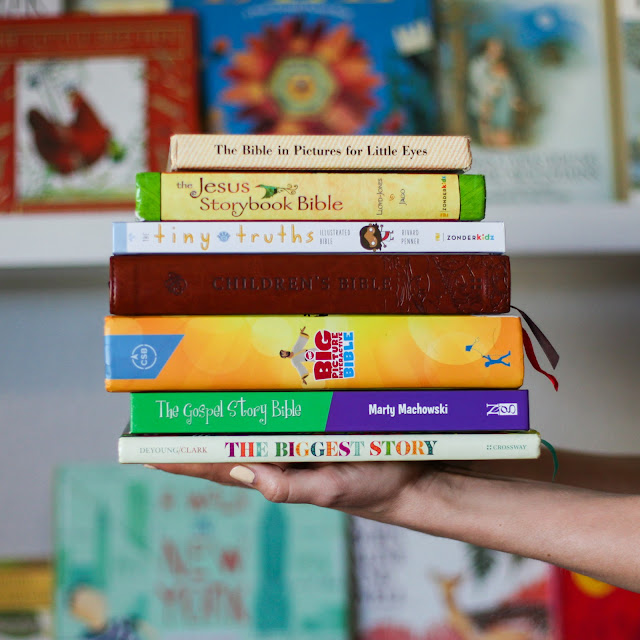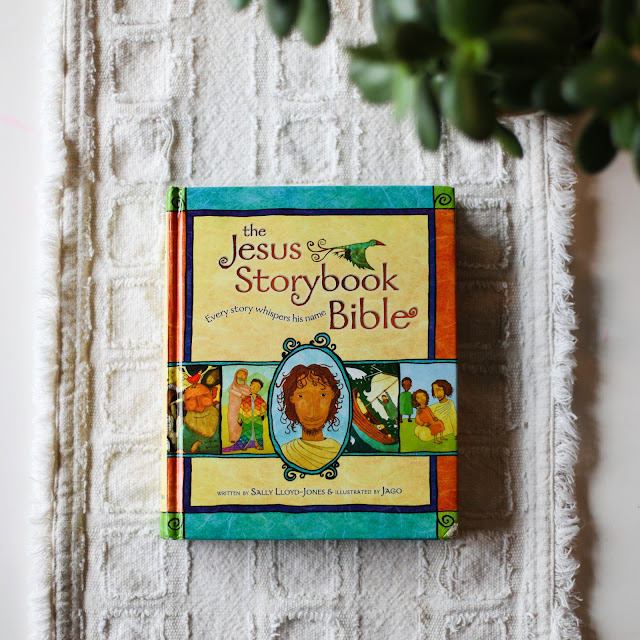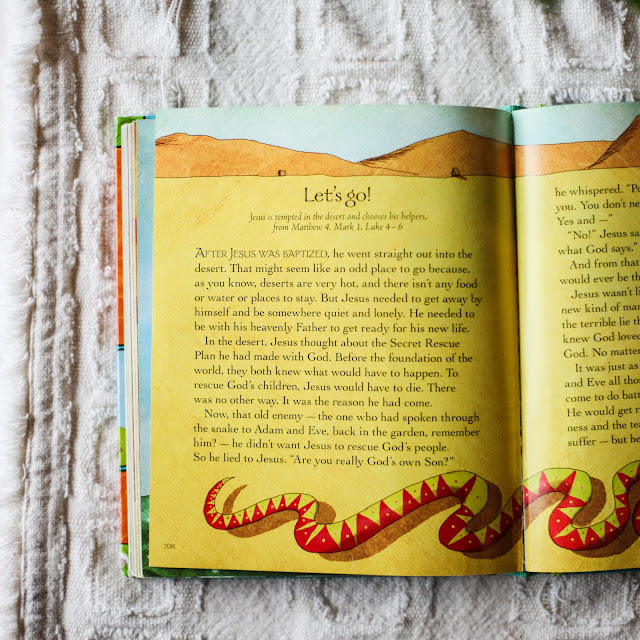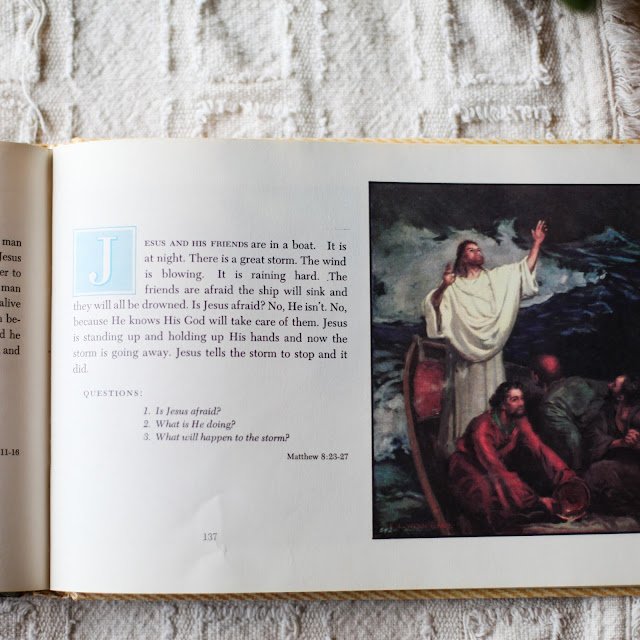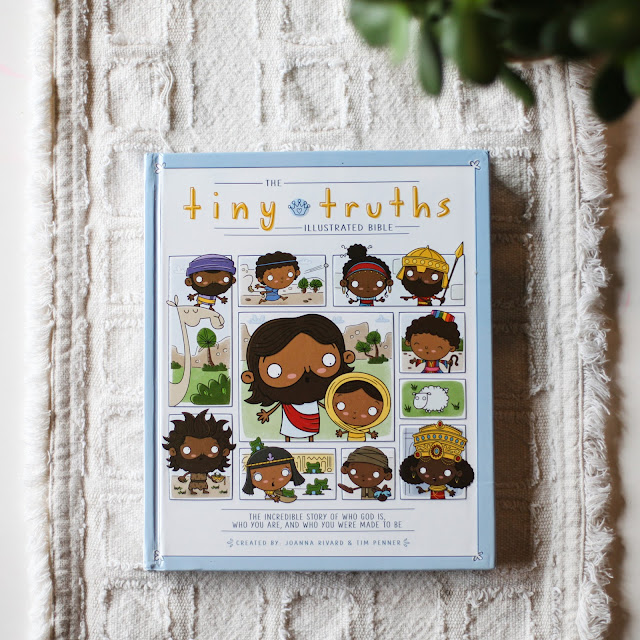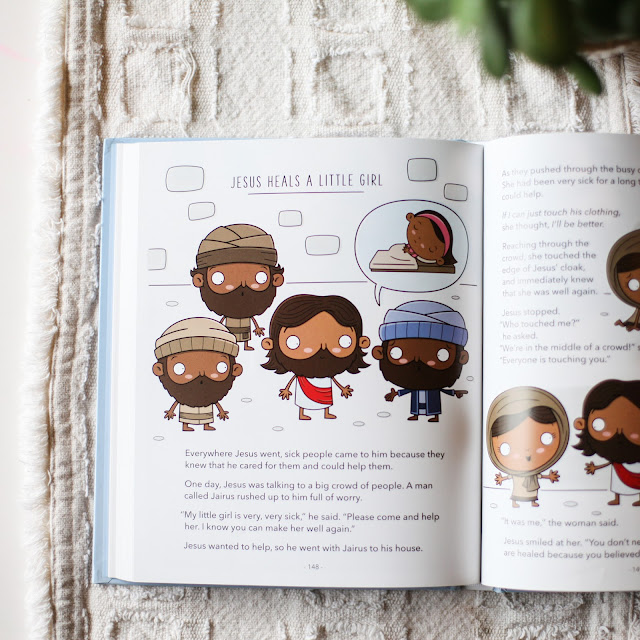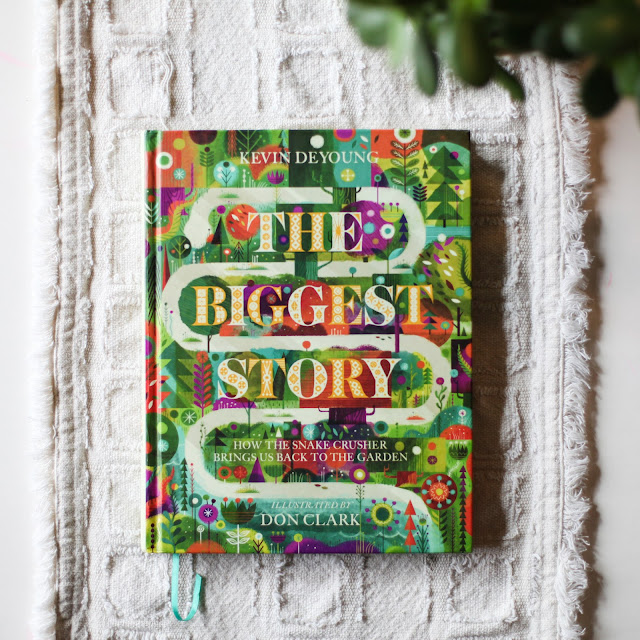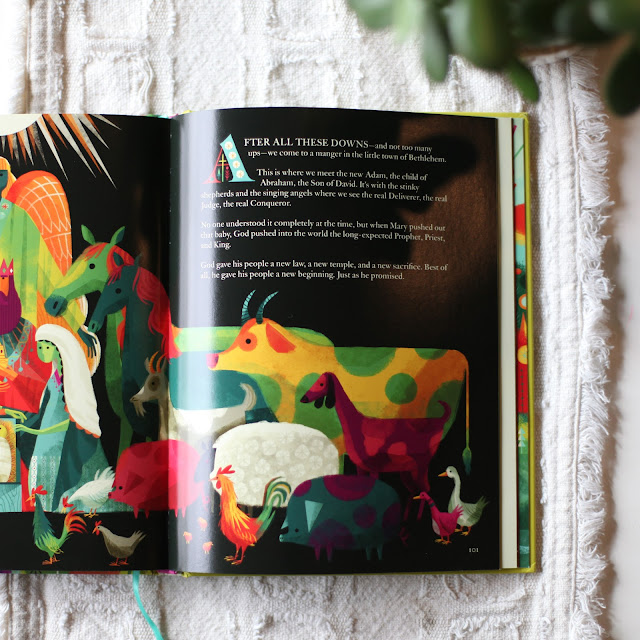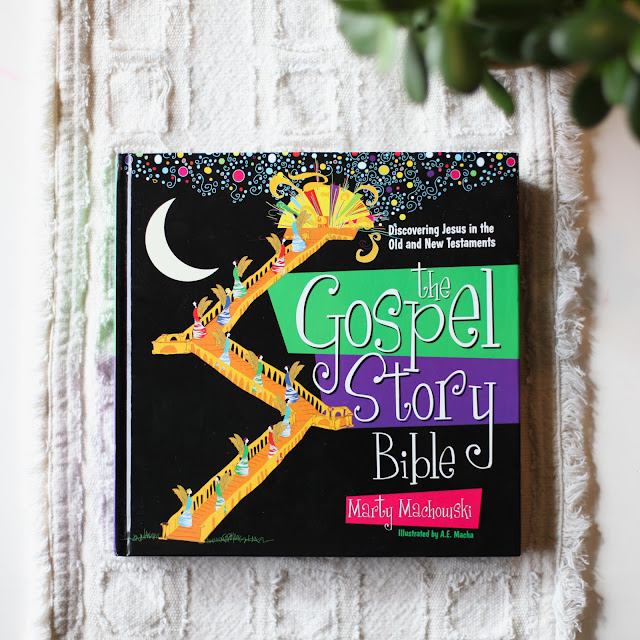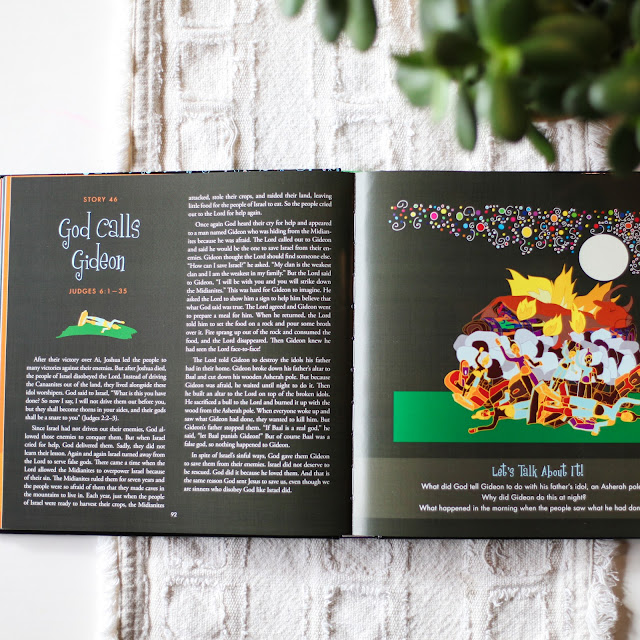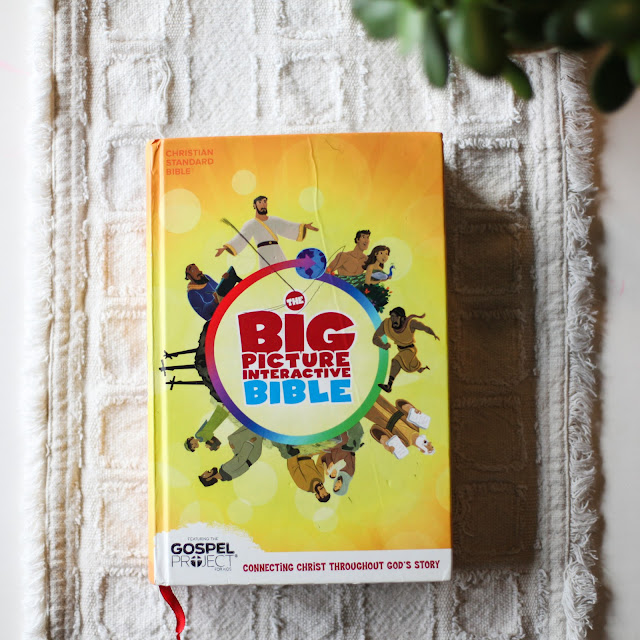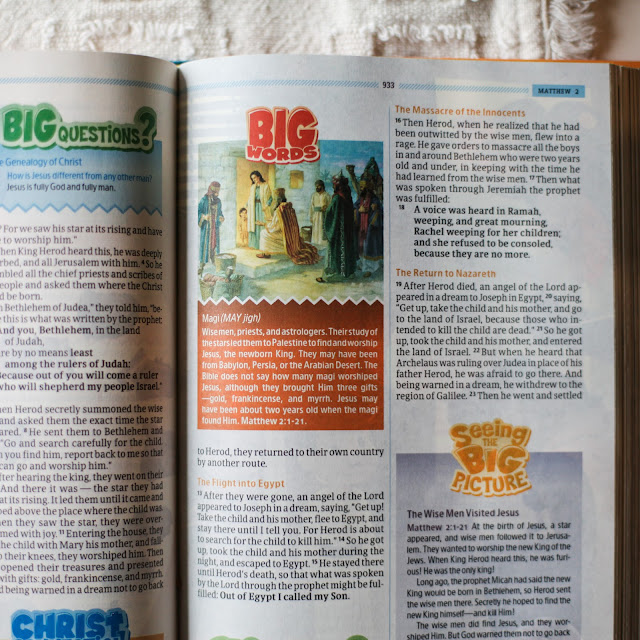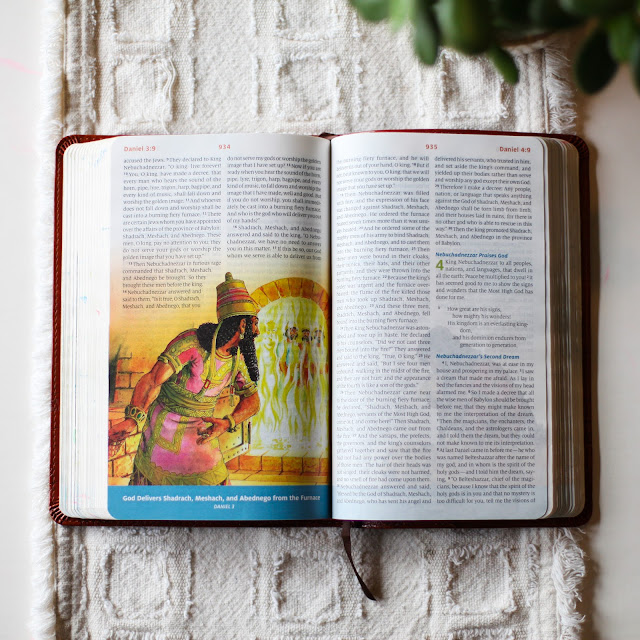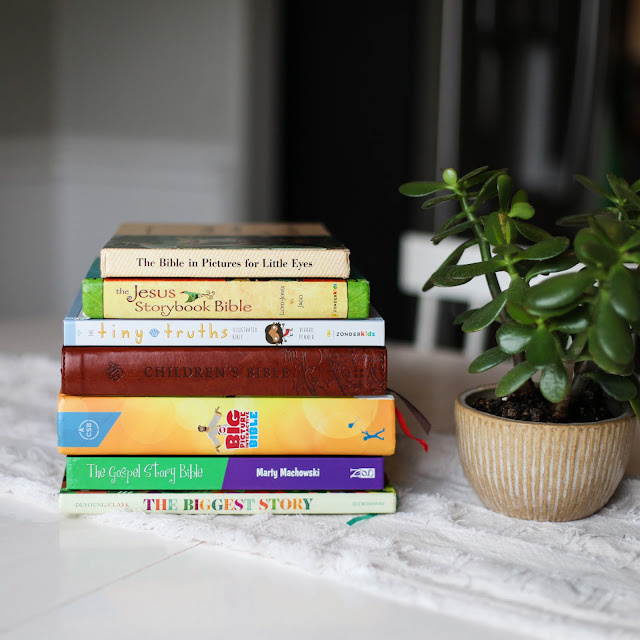Let's talk about children's Bibles. There is such a myriad of choices that I hope it will be helpful to share some of our family's favorites for different age groups.
Differentiating between "The Bible" and "Children's Bible Storybooks"
First, I know some parents are hesitant to use children's Bibles because it "dumbs down" the stories. But I still believe there's a place for children's Bibles, and I believe we can differentiate between calling these children's Bible storybooks "the Bible." They are two different things. My children have no trouble understanding that these books tell the stories of the Bible, but that we spend time reading and memorizing the "real" Bible as well.
The important thing is that you're exposing your children to God's Word. Children's Bible storybooks - especially those that are beautifully written and illustrated - have the ability to awaken a child's imagination and understanding about Jesus. They are able to give a zoomed out version of the story so it's easier to understand when reading or listening from an adult translation of the Bible. By reading about the work of Jesus on our behalf in a Bible or a children's Bible storybook, you are following the commands of Deuteronomy 6:4-9: storing up God's Word in your hearts, impressing them upon your children, and talking about them throughout your days.
Our Favorite Children's Bible Storybooks
Soon after The Jesus Storybook Bible was published in 2007, I read a copy as a newly married Bible college graduate and it opened my eyes to Biblical theology in a way I'd never seen. The way this storybook Bible connects the dots and points to Jesus throughout the Old Testament is breathtaking. It was such a gift, then, to read this to each of our children until we wore out copy after copy. I can't tell you how many of these we've given as baby shower gifts - partly for the child, but mostly for the parent. If you don't have a copy - no matter how old your children are - buy one. I recommend it wholeheartedly.
I actually purchased this for 30 cents at a thrift store and fell in love. I have
the original edition, published in 1956, and the illustrations are exquisite. There's also
a newer edition. This is a perfect Bible for our younger children (currently ages 3 and 5) who really enjoy the short stories and the questions at the end. It's straightforward but helpful. It also tackles the more obscure stories that the average children's Bible might stay away from.
I originally purchased this Bible because of its representation of diversity. Jesus was not white, and unfortunately is portrayed as white in many children's Bibles. This Bible shows darker skin tones across the board, which I appreciate. This includes 33 stories from the Old and New Testaments in clear language for kids. This is not the first children's Bible I would recommend as the stories are not as comprehensive as I wish they were and do not seem to explain theological concepts as much as other storybooks mentioned. But I still think it's a valuable resource to have in your library.
This is definitely more along the lines of a storybook than a Bible, but it's beautifully illustrated and helpful to read with older children in one or two sittings to see the Bible as grand narrative (which is so important!). I do believe it's a little vague for younger children. For example, Jesus is called "The Snake Crusher" throughout the book until page 114 when he is finally called Jesus. That was confusing for my children at first, so I definitely don't think this should replace anything in your library... but would make a good addition. There's also an animated short film by Crossway that accompanies this Bible
that you can view for free here.
This is the children's Bible I chose to use with my
Morning Time plans. We use it much like a commentary. It summarizes the stories then sheds light on the gospel application. It also contains the Bible references at the top of each story, so you can read the stories from the Bible before reading in this book. Many mornings, we'll read from the real Bible, then just read the last paragraph or two from
The Gospel Story Bible as it helps us process what we just read. It also has optional comprehension questions at the end of each story. This is a wonderful option for elementary ages.
As you can see, there is no perfect children's story Bible. All have something beautiful and rich to offer, but none are the infallible Word of God.
Our Favorite Children's Bibles
This is an actual Bible in the CSB version with illustrations and other features added to enhance children's understanding. This is the Bible we've purchased for our two oldest children when they first began reading. It includes easy-to-understand introductions for each book of the Bible, full-color maps, memory verse suggestions, and the "Christ Connection" feature that shows how Bible stories point to Christ. I really love how this is the unabridged Bible, and also keeps my children engaged.
Similar to the previous Bible I mentioned, this is a complete Bible (ESV version) that contains added features: full-color illustrations, child-friendly maps, a dictionary, and Old and New Testament timelines. I believe the ESV is a little more difficult to understand than the CSB, but my son has this Bible and enjoys bringing it to church to be able to follow along with the sermon.
Bible Storybooks We Didn't Love
The Beginner's Bible - While readable by very early readers (there are only a few words on each page), the cheesy illustrations and dumbed down storylines were enough to choose something else.
Egermeier's Bible Story Book - This is a popular choice among homeschoolers, but one we really struggled through our first year of homeschooling. It wasn't all that different from reading directly from the Bible as it is very comprehensive, but I could feel my children losing interest quickly and knew we needed to shelve it for a later time.
A Note about Charlotte Mason
Finally, a note to the Charlotte Mason homeschoolers who may be reading this. Many adherents to Charlotte Mason's philosophy do not buy into the idea of a children's Bible, since Charlotte Mason herself said it was important to expose children to the beautiful language of the King James Version of the Bible from an early age.
However, as I dug a little deeper, I found that Charlotte Mason also wrote about the impediment that archaic language can be to young children. This quote from Volume 2 is lengthy, but worth the read:
"But the little English child is thrust out in the cold by an archaic mode of address, reverent in the ears of us older people, but forbidding, we may be sure, to the child. Then, for the Lord's Prayer, what a boon would be a truly reverent translation of it into the English of to-day! To us, who have learned to spell it out, the present form is dear, almost sacred; but we must not forget that it is after all only a translation, and is, perhaps, the most archaic piece of English in modern use: 'which art,' commonly rendered 'chart,' means nothing for a child. 'Hallowed' is the speech of a strange tongue to him - not much more to us; 'trespasses' is a semi-legal term, never likely to come into his every-day talk; and no explanation will make 'Thy' have the same force for him as 'your.' To make a child utter his prayers in a strange speech is to put up a barrier between him and his 'Almighty Lover.' Again, might we not venture to teach our children to say 'Dear God'? A parent, surely, can believe that no austerely reverential style can be so sweet in the Divine Father's ears as the appeal to 'dear God' for sympathy in joy and help in trouble, which flows naturally from the little child who is 'used to God.' Let children grow up aware of the constant, immediate, joy-giving, joy-taking Presence in the midst of them, and you may laugh at all assaults of 'infidelity,' which is foolishness to him who knows his God as - only far better than - he knows his father or mother, wife or child" (Vol. 2, pp. 56, 57).
Wow. Those words speak so loudly. For me, it's hard to imagine that our only exposure to the Bible in the KJV would develop a deep love for God's Word in our children - though that is what some ardent followers of Charlotte Mason espouse. I want to present to my children the living, breathing, relevant, powerful Word of God in words that can be readily understood.
That said, I am not making the jump that Charlotte Mason would have loved children's Bibles. But I do think this gives us the freedom as Charlotte Mason educators to employ a translation that makes sense for our families. That may not be KJV. In our home, we read regularly from the NIV or the ESV and memorize from both. The NIV tends to be easier to understand, but the ESV is what our church uses. Then usually before bedtime, we'll read a story or two from a children's Bible storybook.
What version of the Bible do you read with your children? What children's Bible is your favorite?







